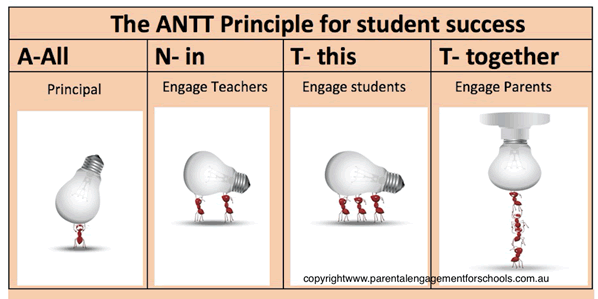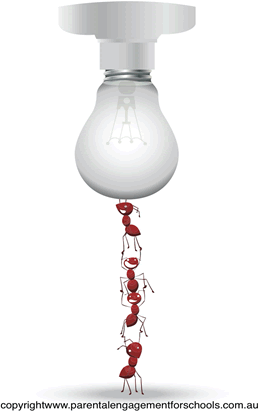Picture this. On arriving to school and before you have time to put your books down, Johnny’s parents make a beeline for you. Words like helicopter, demanding or lawnmower parent come to mind. You are not alone. Just like the 82% of other Australian teachers who list strategies for working with parents as their greatest professional learning need, you have a flight or fight moment.
As a Principal, I also had those moments and sometimes found it easier to keep parents at a distance- preferably at the school gate. When I resigned from Principalship and moved towns, I saw school from the other side of the desk and felt first-hand “the keep them at the gate or classroom door” phenomenon. I found it hard to communicate the special learning needs of my 3 children- one who is ADHD and two who are Dyslexic. I started wondering, if I found it hard how did other parents who did not have my background fare? I realized as a parent, I have the greatest vested interest in my child’s success or otherwise. With one child finishing Year 12 and the other two now 22 and 25 I also realized that the greatest problems are actually after they leave school. They may be with a teacher for 12months but it’s their parents who worry about them for life.
What I do know is all parents just want the best for their child but are looking for good quality information on effective strategies and without guidance, sometimes they choose the wrong strategy.
The goals of this article
- to see parents as part of the solution rather than the problem as we are all in this together- like ants working together for the benefit of the whole community.
- To introduce 6 simple and evidence-based, effective Parental engagement strategies.
It is not about parents being helpers in the classroom or telling teachers how to teach. Teachers are the experts in the classroom and should stand tall and proud of this expertise.
Types of Parental Participation:
Parents helping in the classroom or working as part of Parents and Friends/ Citizens Association or the fete committee is only the first level of parental participation –parental involvement. Although these activities can build community, they have no effect on student achievement (Harris & Goodall, 2008).
The second level of involvement is parental engagement in their child’s learning and the most effective place that is done is in the home (Harris & Goodall, 2008).
The third level is parental empowerment in which parents are able to improve their child’s and their own life chances as a result of training received though the school.
Parents have knowledge about their children that is hard for teachers to know especially because of the number of students teachers are responsible for. Schools need to find ways to pay homage to this knowledge through 2-way mutually respectful relationships. Relationships that respect each other’s expert knowledge.
We are all in this together, or the ANTT Principle for the success of all students- their achievement and wellbeing- and for wellbeing of teachers, School leadership and Parents.
- The principal, the queen ant, cannot do it alone.
- The principal enlists the crucial help of teachers as they are the ones who have the greatest effect (.4) on student achievement (Hattie, 2008). Teachers enlist the help of other teachers as they are more effective when working collaboratively (Hargreaves & Fullan, 2012).
- Teachers engage students in their own learning and they start asking questions – where am I at? What type of learning am I experiencing – deep, surface? Do I know what needs to be done next and where to go for help? (Sharratt & Planche, 2016)
- If we engage parents as well, instead of leaving this willing army at the gate or the classroom door, we can double potential effect on student success.
How? Parents can have the same effect as Teachers (.43 Nye, Turner & Schwartz, 2006) effect or higher (.74) according to Jeynes (2005).
This begs the question – Doing what?
There are 6 effective strategies that parents can use in the home just as there are 10 high impact strategies that teachers should focus on in the classroom according to Hattie (2012) and Marzano (2007). If parents are taught the language of learning (Clinton, Hattie, Dixon, 2007) and the rules and expectations of the classroom and teachers share with them the why of the learning they can actually extend that learning into the home. When the home and school work together the outcomes for students are greater (Harris & Goodall, 2008). Parent and family wellbeing relies on knowing that their role is not to pull their hair out with homework or to teach the content of the subject but to develop in their child traits such as persistence and grit and when to use which high impact strategy. Homework that involves the interaction of parents and child has a greater impact.
- Effective strategies are
- lead learning in the home
- 2-way home school partnership based on mutual respect of each other’s knowledge
- Have high aspirations and realistic expectations for their children which are formulated from the collaborative conversations.
- Develop age appropriate balance between boundaries and love- authoritative parenting
- Teach your children the value of life-long learning
- Begin early and stay engaged throughout their schooling
Need for training
Professional learning is required for both teachers and parents to make these strategies part of the culture of the school. A second tier of learning is required to develop parent and teacher leaders with the skills to work together in collaboration to promote these 6 effective strategies for parental engagement with other parents and staff. A trial is taking place in Queensland where a registered training organization is working with this researcher to give parent participants qualifications recognized not just in the school, but which can be used to pursue further training and accreditation. This is when schools move from parental involvement, through parental engagement to arrive at parental empowerment.
Seeing parents as ants whose help can be enlisted is necessary for the wellbeing of teachers because teachers are crucial to not only the success – achievement and wellbeing- of students but also that of their family and the community in which they live. Isn’t that why we became teachers?
References:
- Clinton, J. & Hattie, J., and Dixon, R. (2007). Evaluation of the Flaxmere Project when families learn the language of school. Retrieved from http://www.educationcounts.govt.nz/publications/schooling/10001
- Hattie, J. A. C. (2012). Visible learning for teachers. London, UK: Routledge.
- Jeynes, W. (2005). A Meta-Analysis of the Relation of Parental Involvement to Urban Elementary School Student Academic Achievement. Urban Education, 40(3), 237-269.
- Marzano, R. J., (2007). The Art and Science of Teaching, Victoria, Australia: Hawker Brownlow.
- Nye, C., Turner, H., & Schwartz, J. (2006). Approaches to parent involvement for improving the academic performance of elementary school age children. Campbell Systematic Reviews 2006:4. Oslo: The Campbell Collaboration.
- Sharratt, L. & Planche, B. (2016) Leading collaborative learning. London, UK: Corwin.
For More information





